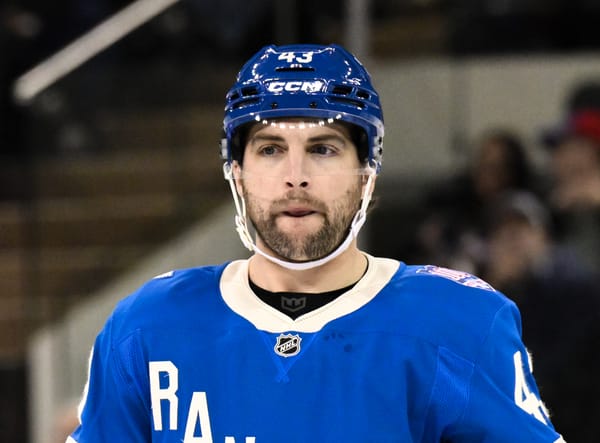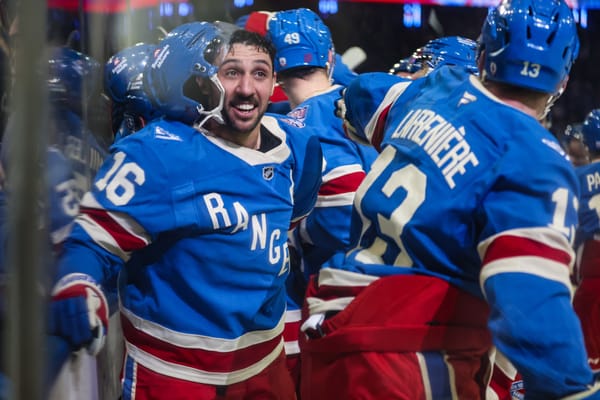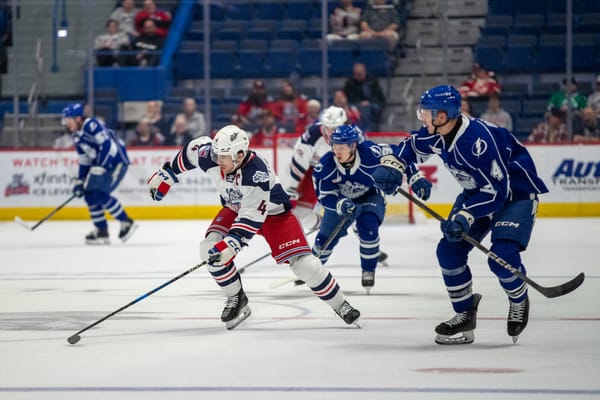Blueshirt Banter 2020 New York Rangers Prospect Rankings: 5-1
You’ll never guess who’s number one!
Before we get into the rankings, I want to set the scene and do some housekeeping.
I don’t think I’m spoiling anything by revealing ahead of time that Alexis Lafrenière is not only the top prospect in the organization but the entire NHL right now. The number-five spot on my list is pretty comfortably occupied as well.
Ranking players two-through-four was exceptionally hard. These three different players are all very good prospects with very different resumes and who, at different points in time, have played like the best prospect among them. I’m not omniscient and the entire list I’ve put together is subjective, but these three in particular really could justifiably be put in any order right now and I’d accept the argument.
Next week I plan on doing a mailbag related to my rankings and Rangers prospects. Please submit any questions you have in the comments section of this article, to my Twitter, or via my email. A Top-24 Under-24 will also be published next week to account for players already on the NHL roster but who are nonetheless very much part of the Rangers’ future. As always, thank you for reading what is the culmination of a year’s work.
5. Zac Jones, Left Defense, UMass Amherst
2019 Ranking: 12
Age: 20
Acquired Via: 2019 Draft (Third Round)
When I ranked Jones 12th in my prospect rankings last season I thought I was being ambitious. Turns out I undersold him.
I don’t think even the Rangers thought Jones would join UMass Amherst and light up college hockey right away. Jones came out the gate absolutely flying, tallying three goals and eight assists in his first ten collegiate games.
That was enough to get the attention of scouts. He then kept their eyes with an impressive showing at the World Junior Championship. The counting numbers were nothing special — one goal and one assist in five games — but Jones was a steady two-way presence for a USA team that lacked any sort of organization.
Jones’ second-half lacked the flair of his first half. In fact, he went on a sizable scoring drought upon his return. Nonetheless, he re-found his form at the end of the season, registering 11 assists over 15 games following his return from World Juniors.
The comparisons to Adam Fox are hard to avoid. Jones, an undersized defenseman who isn’t a particularly good skater, processes the game at such a high level. He just always seems to know what the right play is with the puck, pushing the pace when the other team is vulnerable or slowing play down and waiting for opportunities to open when there’s congestion. He’s a skilled passer who can start the breakout but also has enough ability to carry himself and keep the opposing forecheck honest. In the offensive zone, he’s an undeniable quarterback who dictates his team’s offense. He’s one of the better teenage defensemen I’ve seen when it comes to shooting for his teammate’s defections.
The offensive skillset is what will draw eyes to him. In the process, I believe, his defensive acumen gets overlooked. He’s a credible defender of puck carriers and always seems to anticipate what decisions they want to make with the puck. He’s quite good at getting his stick in passing lanes and breaking up plays. He’s proven to be a strong two-on-one defender.
Defending around the slot and battling for pucks are still works in progress and I wouldn’t expect those to become strengths of his. Will Jones be a player the coach rushes over the boards to do the bulk of a team’s penalty killing? Probably not. I do still think he can and should be classified as a two-way defenseman.
Some may view my ranking of Braden Schneider (6th on my list) below Jones as a slight against Schneider. Instead, it should highlight my belief in Jones. He’s an intelligent player in so many different aspects of the game and his overall impact is only going to get better as he physically matures and makes improvements to his skating and strength. I can’t see him staying in college beyond his junior season, and if the remainder of the 2020-21 season goes well he may very well sign by the summer. Unfortunately, I think Jones’ lack of physical tools hinders his upside, but I think he could very well become a quality second-pairing defenseman.
There’s no chance in hell that he’s falling into the third round in a redraft of 2019. The Rangers did a great job scouting and assessing Jones in 2019.
4. Vitaly Kravtsov, Right Wing, Traktor Chelyabinsk (KHL)
2019 Ranking: 2
Age: 20
Acquired Via: 2018 Draft (First Round)
Vitaly Kravtsov’s (pre-)New York Rangers career has mimicked a sine wave. Coming into last year’s training camp, Kravtsov had just put together a strong KHL season and World Junior Championship showing. The expectation was that he would, if not make the Rangers’ opening night lineup, would then work on his game in the AHL for a month or two before making his NHL debut.
Instead, Kravtsov struggled in training camp. Then, he struggled immensely in Hartford to the point that he got sat multiple times. He returned back to Russia to play for Traktor in the KHL again, then performed so poorly with them that he was demoted to the VHL, Russia’s second tier.
Humbled and humiliated, Kravtsov agreed to return back to Hartford and give it another go. It would be a stretch to say he excelled in his second stint, but it was certainly a notable improvement. He was putting in effort off of the puck, backchecking hard and moving to get open in the offensive zone.
Had this been a normal offseason, the report on him I’d have offered in July or August would have been incredibly harsh.
However, the Rangers sent him back to Traktor to see games while the NHL waits to return. He’s looking more or less back on track. Kravtsov started the year white-hot with six goals in seven games. He was demonstrating changes in his game. He kept his feet moving in the offensive zone to get open for scoring opportunities. He was battle for pucks to keep plays alive. His skating was better.
He’s since cooled off. Partly because his offensive numbers were unsustainable, partly because his play has dipped, and partly because his teammates are letting him down. On the whole, nine goals in 28 games is much more what the Rangers are expecting from him; the lack of assists is truly due to inadequate linemates.
We know what Kravtsov can do. His puck skills are borderline elite. There are few prospects in the world as good at taking on defenders. He’s shifty and crafty and can create his own shot. He can beat goaltenders clean from pretty much anywhere in the offensive zone thanks to deceptive hands and little tell in his release. He’s a tremendous playmaker when he has linemates who can keep up. In a skills competition, Kravtsov would dominate. There are also times where he’s one of the hardest-working players on the ice. Numerous times this season he’s saved Traktor with a heroic backcheck.
The problem is consistency. It’s not enough to have one or two great shifts in either end of the rink. He needs to be a more consistent presence in supporting the puck, forechecking, and moving into positions to make plays. Lafreniére aside, if Kravtsov becomes the best player on this list it will be a surprise to nobody. I still would not rule out an All-Star ceiling. Perhaps a more realistic hope is for Kravtsov to become a second-line winger who produces 45-50 points every season. While that may not be the dream scenario many hoped for a year ago, it would still make him a very good player to have and a worthy ninth-overall selection.
3. K’Andre Miller, Left Defense, Hartford Wolf Pack (AHL)
2019 Ranking: 3
Age: 20
Acquired Via: 2018 Draft (First Round)
Miller didn’t have a bad 2019-20 season, but it definitely was not the overwhelming success that was his freshman season at Wisconsin. Miller scored just two more goals and tallied 11 fewer assists as a sophomore despite playing 10 more games. At the World Junior Championship, his play for the USA was inconsistent.
The numbers at Wisconsin don’t tell the whole story. In fact, it misses half of the novel. The Badgers, on the whole, were a disaster. Despite a much-hyped incoming freshman class, Wisconsin finished last in the Big Ten and held a 14-20-2 overall record. On the ice, the team looked disorganized and sloppy. The goaltending was atrocious. Almost every player played below his means.
I would say that Miller was among the players to best mitigate the teamwide onslaught. As much as his offensive numbers suffered, his defensive play didn’t. His presence on the ice is immense. With his size and speed, he can close gaps in a hurry. He’s quick enough to outright win races. If it’s close, he almost always has a physical advantage. Add in an active, rangy stick, and rush through Miller’s side of the ice at your own peril.
Despite the scoring decline, I was impressed by Miller’s command of the puck from the back-end. When the Rangers drafted him, he was good for the occasional north-south rush of the puck through the neutral zone. He’s added an ability to beat forecheckers with agility, carrying around them at controlled tempos, rather than solely straight-line speed. Even more encouraging was that his passing ability has improved. I don’t think he’s going to be a playmaker in the offensive zone, but he’s capable of advancing the puck to forwards at the blue line to create zone entries.
Watch these few highlights and try to remember if you’ve ever seen a player so physically dominant over his peers.
Miller is still very raw and unproven, which creates equal portions of uncertainty and excitement. He’s going to get his 200+ games in the NHL, in all likelihood, if only because his physical makeup will earn him the benefit of the doubt. But what will he become? Even in college, he was such a physically dominating presence. When that factor is mitigated at the NHL level, will he be able to think the game sufficiently to make the most of his talents?
If he can, then the Rangers will have a rare player. There are so few defensemen who can skate like he can at his size. He’s not going to be a major point producer, but I think there’s enough skill there to drive play for his team. The tools are absolutely there to become a top shutdown defenseman. K’Andre is determined to learn and improve. Coaching will go a long way in determining what becomes of him.
If Miller reaches his peak, he’ll be a top-pairing defenseman and #1 penalty-killing defenseman. He’ll join the rush and do his part to advance the puck, but will leave the playmaking to his teammates. On raw ability alone, he could fit in as a depth defenseman who plays tough defensive minutes. I think it’s a very good bet that the Rangers landed an NHLer in Miller. It’s still to be determined how impactful he will be, and it might take a few years for him to really find his game at the NHL level.
2. Nils Lundkvist, Right Defense, Luleå (SHL)
2019 Ranking: 6
Age: 20
Acquired Via: 2018 Draft (First Round)
After a so-so post-draft season, Lundkvist could not have had a more explosive 2019-20 season. His 11 goals and 20 assists in 41 games were a shock to people like me, who recognized his offensive capabilities but felt he would provide transition offense more than point production. The underlying numbers were strong as well, and he amassed one goal and seven assists in seven World Junior Championship games for Sweden. His SHL numbers set a record for under-20 defensemen, although I have to caution that he only owns that title because players such as Victor Hedman and Rasmus Dahlin, among others, jumped to North America in their teens.
I also don’t think he’ll ever quite repeat that performance. Lundkvist’s production this season with Luleå is more reasonable, with five goals and six assists through 20 games so far. Even with the decline, my skepticism of his offensive game has turned into belief. I think he is a legitimate offensive defenseman and that his ability to get on the scoresheet will translate at the NHL level. It’s deceptive because he’s small and unassuming, but Lundkvist can really let it rip from the circles and above, and in different ways. He’s Luleå’s triggerman on the power play. He blasts home slapshots on the one-timer, often coming laterally from the other point or on a low-to-high pass. He also has some delicacy, too. He can corral the puck and wire a wrister top shelf through traffic.
While his playmaking is not on par with that of Adam Fox or Tony DeAngelo, he can make some creative passes, too. He can start a rush from the back-end and, in the offensive zone, he is quite good at feinting a shot and sending a diagonal pass to a forward down low. He’s very comfortable activating in the offensive zone to become a fourth forward and he has the foot speed to get back.
Lundkvist remains a capable defensive player. He’s growing and now has the ability to leverage players off of pucks. He is still sometimes getting lost in his coverages on controlled plays in the defensive zone. One of the many beauties of Lundkvist’s status as a prospect is that, as a late-July birthday, he is still just 20 years old. He has two-to-three years yet before he reaches his prime as a hockey player, which gives him plenty of time to get stronger and improve the nuances of organized defending.
Ironically, if all of Kravtsov, Miller, and Lundkvist reach their ceilings, the Swede likely would be the “worst” of the trio. I still have him ranked second because his ceiling is quite high and he offers a tremendous amount of certainty. He’s a top-pairing, all-situations defenseman for one of the top teams in the world outside the NHL. This should be his last season in Sweden, with the Rangers signing him and bringing him over to North America next season. What happens short-term will rely on the roster makeup as much as anything. Perhaps he takes a short tour of Hartford to get acclimated, but it shouldn’t be long before Lundkvist is playing regular, unsheltered minutes for the Rangers. A realistic expectation is that Lundkvist becomes a two-way defenseman who does a bit of everything for the team and consistently hits 30 points. He’s a no-doubt top-five defense prospect in the world right now.
1. Alexis Lafrenière, Left Wing, New York Rangers
2019 Ranking: N/A
Age: 19
Acquired Via: 2020 Draft (First Round)
This is the easiest ranking I’ve ever had to do and I assume that will remain the case for eternity. Forget the Rangers; Lafrenière is the best prospect in the world.
I worked hard on a Lafrenière scouting report following the Rangers’ lottery win and I’m quite proud of that article. One way or another, you are surely familiar with him. He’s a superstar in the making with zero holes in his game. If all works out, he will be a top-five playmaker in the NHL within a few years while scoring his fair share as well. He works hard, battles for loose pucks, is willing to get around the crease and take punishment to make a play, and plays defense beyond his years. The one knock on him is that his skating is pretty good rather than great, and that may be what keeps him a tier below the likes of Sidney Crosby and Alexander Ovechkin.
If and when the NHL regular season finally starts, Lafrenière will make the roster and should contribute right away. It’s hard to imagine that anyone besides him being the best player on the team within five years.
Again, if you wish to learn more, please check out the scouting report I linked. Otherwise, there’s no need to drag this out any further.
Catch up on previous entries in this series through the link below.
Related
2020 Blueshirt Banter Prospect Rankings




